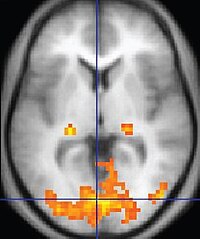
Photo from wikipedia
ABSTRACT Comparing the neural outcomes of two randomized experimental groups is a primary aim of many functional neuroimaging studies. However, between‐group effects can be obscured by heterogeneity in neural responses.… Click to show full abstract
ABSTRACT Comparing the neural outcomes of two randomized experimental groups is a primary aim of many functional neuroimaging studies. However, between‐group effects can be obscured by heterogeneity in neural responses. Optimal Combined Moderator (OCM) approaches have previously been used to clarify heterogeneity in clinical outcomes following treatment randomization. We show that OCMs can also be used to clarify heterogeneity in the effect of a randomized experimental condition on neural responses. In 78 healthy adults aged 18–30 from the Effects of Dose‐Dependent Sleep Disruption on Fear and Reward (SFeRe) study, we used demographic, clinical, genetic, and polysomnographic characteristics to develop OCMs for the effect of a randomized sleep restriction (SR) versus normal sleep (NS) condition on blood‐oxygen‐level dependent responses in the right amygdala (RAmyg) and subgenual anterior cingulate cortex (sgACC) during fear conditioning (FC) and extinction (FE) paradigms. The OCM for the RAmyg during FE was strongest [r (95% CI)=0.52 (0.42, 0.68)], withstood cross‐validation, and divided the sample into two subgroups with opposing experimental effects. Among N=48 participants (“SRNS”), those with SR exhibited greater RAmyg activation during FE following SR than those with NS [d (95%CI)=0.87 (0.37,1.78)]. SR>NS participants were more likely to be female, white, l/l genotype carriers, and have a psychiatric history. They had less sleep (overall and in REM), lower REM density, and lower spindle activity (12–16Hz). Applying OCMs to randomized studies with neural outcomes can clarify neural heterogeneity and jumpstart mechanistic research; with further validation they also offer promise for personalized brain‐based treatments and interventions. HIGHLIGHTSWe analyzed heterogeneity in an fMRI study of sleep restriction/fear extinctionOptimal Combined Moderator (OCMs) were used to define this heterogeneityOCMs defined subgroups with more/less activation in randomized conditionsOCMs could eventually be used to guide personalized brain‐based interventions
Journal Title: NeuroImage
Year Published: 2018
Link to full text (if available)
Share on Social Media: Sign Up to like & get
recommendations!